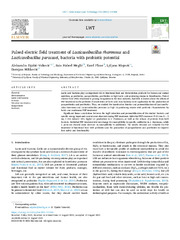Pulsed electric field treatment of Lacticaseibacillus rhamnosus and Lacticaseibacillus paracasei, bacteria with probiotic potential
Аутори
Đukić-Vuković, Aleksandra
Meglic, Sasa Haberl
Flisar, Karel
Mojović, Ljiljana

Miklavcic, Damijan
Чланак у часопису (Објављена верзија)
Метаподаци
Приказ свих података о документуАпстракт
Lactic acid bacteria play an important role in functional food and fermentation products for human and animal nutrition, as probiotics, paraprobiotics, postbiotics or high-lactic acid-producing strains in biorefineries. Pulsed electric field (PEF) treatment is gaining recognition in the food industry, but little is known about the effects of PEF treatment on the probiotic characteristics of lactic acid (LA) bacteria or its application for the production of paraprobiotics and postbiotics. Thus, we studied the inactivation kinetics and permeabilization of Lacticaseibacillus rhamnosus and Lacticaseibacillus paracasei as high LA-producing strains with probiotic characteristics by batch and continuous PEF treatment. Significant linear correlations between the logN reduction and permeabilization of the studied bacteria and specific energy input and current were observed during PEF treatment. Sublethal PEF treatment (5 kV/cm, 8 x 1 ms, 1 Hz) induced 10% higher LA production in L. rhamnosus, a...s well as the release of proteins from both bacteria. Sublethal PEF treatment did not change the susceptibility to specific antibiotics in L. rhamnosus, while L. paracasei showed some decrease in susceptibility to antibiotics. The results obtained are valuable for PEF treatment of functional food with probiotics and the production of paraprobiotics and postbiotics to improve food safety and functionality.
Кључне речи:
Electroporation / Lactic acid bacteria / Probiotic / Microbial inactivation / Paraprobiotic / PostbioticИзвор:
Lwt-Food Science and Technology, 2021, 152Финансирање / пројекти:
- Министарство науке, технолошког развоја и иновација Републике Србије, институционално финансирање - 200135 (Универзитет у Београду, Технолошко-металуршки факултет) (RS-MESTD-inst-2020-200135)
DOI: 10.1016/j.lwt.2021.112304
ISSN: 0023-6438
WoS: 000696922400010
Scopus: 2-s2.0-85113877732
Институција/група
Tehnološko-metalurški fakultetTY - JOUR AU - Đukić-Vuković, Aleksandra AU - Meglic, Sasa Haberl AU - Flisar, Karel AU - Mojović, Ljiljana AU - Miklavcic, Damijan PY - 2021 UR - http://TechnoRep.tmf.bg.ac.rs/handle/123456789/4804 AB - Lactic acid bacteria play an important role in functional food and fermentation products for human and animal nutrition, as probiotics, paraprobiotics, postbiotics or high-lactic acid-producing strains in biorefineries. Pulsed electric field (PEF) treatment is gaining recognition in the food industry, but little is known about the effects of PEF treatment on the probiotic characteristics of lactic acid (LA) bacteria or its application for the production of paraprobiotics and postbiotics. Thus, we studied the inactivation kinetics and permeabilization of Lacticaseibacillus rhamnosus and Lacticaseibacillus paracasei as high LA-producing strains with probiotic characteristics by batch and continuous PEF treatment. Significant linear correlations between the logN reduction and permeabilization of the studied bacteria and specific energy input and current were observed during PEF treatment. Sublethal PEF treatment (5 kV/cm, 8 x 1 ms, 1 Hz) induced 10% higher LA production in L. rhamnosus, as well as the release of proteins from both bacteria. Sublethal PEF treatment did not change the susceptibility to specific antibiotics in L. rhamnosus, while L. paracasei showed some decrease in susceptibility to antibiotics. The results obtained are valuable for PEF treatment of functional food with probiotics and the production of paraprobiotics and postbiotics to improve food safety and functionality. T2 - Lwt-Food Science and Technology T1 - Pulsed electric field treatment of Lacticaseibacillus rhamnosus and Lacticaseibacillus paracasei, bacteria with probiotic potential VL - 152 DO - 10.1016/j.lwt.2021.112304 ER -
@article{
author = "Đukić-Vuković, Aleksandra and Meglic, Sasa Haberl and Flisar, Karel and Mojović, Ljiljana and Miklavcic, Damijan",
year = "2021",
abstract = "Lactic acid bacteria play an important role in functional food and fermentation products for human and animal nutrition, as probiotics, paraprobiotics, postbiotics or high-lactic acid-producing strains in biorefineries. Pulsed electric field (PEF) treatment is gaining recognition in the food industry, but little is known about the effects of PEF treatment on the probiotic characteristics of lactic acid (LA) bacteria or its application for the production of paraprobiotics and postbiotics. Thus, we studied the inactivation kinetics and permeabilization of Lacticaseibacillus rhamnosus and Lacticaseibacillus paracasei as high LA-producing strains with probiotic characteristics by batch and continuous PEF treatment. Significant linear correlations between the logN reduction and permeabilization of the studied bacteria and specific energy input and current were observed during PEF treatment. Sublethal PEF treatment (5 kV/cm, 8 x 1 ms, 1 Hz) induced 10% higher LA production in L. rhamnosus, as well as the release of proteins from both bacteria. Sublethal PEF treatment did not change the susceptibility to specific antibiotics in L. rhamnosus, while L. paracasei showed some decrease in susceptibility to antibiotics. The results obtained are valuable for PEF treatment of functional food with probiotics and the production of paraprobiotics and postbiotics to improve food safety and functionality.",
journal = "Lwt-Food Science and Technology",
title = "Pulsed electric field treatment of Lacticaseibacillus rhamnosus and Lacticaseibacillus paracasei, bacteria with probiotic potential",
volume = "152",
doi = "10.1016/j.lwt.2021.112304"
}
Đukić-Vuković, A., Meglic, S. H., Flisar, K., Mojović, L.,& Miklavcic, D.. (2021). Pulsed electric field treatment of Lacticaseibacillus rhamnosus and Lacticaseibacillus paracasei, bacteria with probiotic potential. in Lwt-Food Science and Technology, 152. https://doi.org/10.1016/j.lwt.2021.112304
Đukić-Vuković A, Meglic SH, Flisar K, Mojović L, Miklavcic D. Pulsed electric field treatment of Lacticaseibacillus rhamnosus and Lacticaseibacillus paracasei, bacteria with probiotic potential. in Lwt-Food Science and Technology. 2021;152. doi:10.1016/j.lwt.2021.112304 .
Đukić-Vuković, Aleksandra, Meglic, Sasa Haberl, Flisar, Karel, Mojović, Ljiljana, Miklavcic, Damijan, "Pulsed electric field treatment of Lacticaseibacillus rhamnosus and Lacticaseibacillus paracasei, bacteria with probiotic potential" in Lwt-Food Science and Technology, 152 (2021), https://doi.org/10.1016/j.lwt.2021.112304 . .


